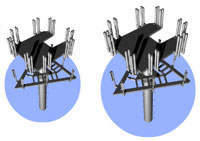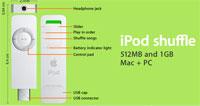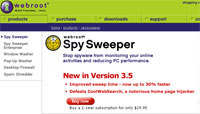 After months of rumours on the Web, details of palmOne’s new LifeDrive PDA have finally shown up on Amazon.
After months of rumours on the Web, details of palmOne’s new LifeDrive PDA have finally shown up on Amazon.
Engadget.com reported that the listing confirms that the US$499 (~£262 ~€385) device will come with a 4GB Hitachi Microdrive, SD card slot, 320×480 hi-resolution colour display (with portrait and landscape viewing) and offer Bluetooth and 802.11b Wi-Fi wireless connectivity.
The LifeDrive handhelds will be powered by a 416MHz Intel XScale PXA270 processor and run on the Palm GarnetOS, which includes support for wireless connections such as Bluetooth.
The device will be a little larger than palmOne’s latest high-end model, the Tungsten T5, sizing up at 4.7 inches tall, 2.8 inches wide, and a pocket-threatening 0.8 inches thick. It will weigh 6.8 ounces.
According to sources, the music-playing device will use Pocket Tunes and sync with Real’s Rhapsody music service, suggesting that it could be seen as a turbo-charged challenger to Apple Computer’s US$199 (~£104 ~€153) 4GB iPod Mini.
 NormSoft’s Pocket Tunes is able to play MP3, WMA, Ogg Vorbis, and WAV files and the unit will also support full screen video and photo playback.
NormSoft’s Pocket Tunes is able to play MP3, WMA, Ogg Vorbis, and WAV files and the unit will also support full screen video and photo playback.
Business users will be catered for with the bundled DocumentsToGo software supporting Word, Excel, PowerPoint, and Acrobat files.
The unit also comes with ‘Camera Companion’ software for transferring photos to and from the device, with ‘Drive Mode’ allowing users to plug their handheld into the USB port on a PC and have the microdrive appear as a removable drive.
 The LifeDrive comes with USB 2.0, so transferring files onto the microdrive should be a fairly nifty business.
The LifeDrive comes with USB 2.0, so transferring files onto the microdrive should be a fairly nifty business.
Despite black leather clad doomsayers predicting the death of the PDA, palmOne clearly thinks that a hard drive-based multimedia device able to take advantage of the immense software resources of the palm platform could be a winner.
There’s certainly industry interest elsewhere, with Dell rumoured to be considering a hard drive based handheld.
Although there’s been no official announcement from palmOne, the LifeDrive is expected to launch in the US on 18th May, 2005.
 Research In Motion (RIM) have announced that that the BlackBerry wireless communicator now boasts 3 million worldwide subscribers, with one million subscribers added in less than six months.
Research In Motion (RIM) have announced that that the BlackBerry wireless communicator now boasts 3 million worldwide subscribers, with one million subscribers added in less than six months. BlackBerry Enterprise Server’s ability to integrate with Microsoft Exchange, IBM Lotus Domino and Novell GroupWise (and other existing enterprise systems) has proved a hit with corporate customers keen to take advantage of push-based wireless access to e-mail and other corporate data.
BlackBerry Enterprise Server’s ability to integrate with Microsoft Exchange, IBM Lotus Domino and Novell GroupWise (and other existing enterprise systems) has proved a hit with corporate customers keen to take advantage of push-based wireless access to e-mail and other corporate data. With the NTP lawsuit now resolved, RIM is free to follow its European initiative and license its Blackberry Connect software to US mobile phone vendors, so we can expect to see more third-party phones and handsets connecting to the service.
With the NTP lawsuit now resolved, RIM is free to follow its European initiative and license its Blackberry Connect software to US mobile phone vendors, so we can expect to see more third-party phones and handsets connecting to the service. It was a bad weekend for Google as the entire site was rendered unavailable on Saturday night and their new Web Accelerator application drew criticism on privacy and security concerns.
It was a bad weekend for Google as the entire site was rendered unavailable on Saturday night and their new Web Accelerator application drew criticism on privacy and security concerns. Deeply unchuffed, Fried complained that “Google’s Web accelerator can wreak havoc on Web-apps and other things with admin-links built into the UI.”
Deeply unchuffed, Fried complained that “Google’s Web accelerator can wreak havoc on Web-apps and other things with admin-links built into the UI.” Sadly, things went from bad to worse on Saturday night when the world’s leading Internet search engine shut down from 6:45 to 7 p.m. eastern time, with some users experiencing longer outages.
Sadly, things went from bad to worse on Saturday night when the world’s leading Internet search engine shut down from 6:45 to 7 p.m. eastern time, with some users experiencing longer outages. Cell phone penetration in Western Europe will hit 100% by 2007 as mobile-loving customers continue to scoop up multiple phones and phone cards.
Cell phone penetration in Western Europe will hit 100% by 2007 as mobile-loving customers continue to scoop up multiple phones and phone cards. Although some people might think that the rise is fuelled by drug dealers toting multiple phones for ‘business’, the increase is actually explained by customers buying multiple phones and/or SIM cards.
Although some people might think that the rise is fuelled by drug dealers toting multiple phones for ‘business’, the increase is actually explained by customers buying multiple phones and/or SIM cards. With a manly backslap, Intel and Sprint have announced that they will work together to advance development of the 802.16e WiMAX standard.
With a manly backslap, Intel and Sprint have announced that they will work together to advance development of the 802.16e WiMAX standard. In case that sounded too simple, here’s Oliver Valente, CTO and VP of technology development for Sprint, to baffle you with a buzzword remix: “Our relationship with Intel will help validate requirements, drive key ecosystem development needs, formulate network strategies and define the potential for advanced wireless services adoption”.
In case that sounded too simple, here’s Oliver Valente, CTO and VP of technology development for Sprint, to baffle you with a buzzword remix: “Our relationship with Intel will help validate requirements, drive key ecosystem development needs, formulate network strategies and define the potential for advanced wireless services adoption”. Sean Maloney, another executive with an impossibly long job description (“executive vice president and general manager of the Intel Mobility Group”) added: “WiMAX technology has the promise to deliver new broadband services to consumers globally.”
Sean Maloney, another executive with an impossibly long job description (“executive vice president and general manager of the Intel Mobility Group”) added: “WiMAX technology has the promise to deliver new broadband services to consumers globally.” Yahoo has pulled a fast one on its rivals by unexpectedly taking it’s
Yahoo has pulled a fast one on its rivals by unexpectedly taking it’s  Finding video content on Yahoo’s new search facility is easy enough: type in the relevant keywords and you’ll be taken to a results page showing thumbnails of the video files. Clicking on the thumbnail takes you to the hosting page with an option to directly view the video.
Finding video content on Yahoo’s new search facility is easy enough: type in the relevant keywords and you’ll be taken to a results page showing thumbnails of the video files. Clicking on the thumbnail takes you to the hosting page with an option to directly view the video. In the interests of research, we rummaged around for naughty porn, but couldn’t find anything too racy – until we spotted the ‘turn safe search off’ option. Clicking on this released a veritable cascade of filth that would send Mary Whitehouse’s graveyard residence spinning in turbo mode.
In the interests of research, we rummaged around for naughty porn, but couldn’t find anything too racy – until we spotted the ‘turn safe search off’ option. Clicking on this released a veritable cascade of filth that would send Mary Whitehouse’s graveyard residence spinning in turbo mode. UK third-generation mobile phone network 3, have teamed up with TV production and distribution company Granada to bring the popular ITV show, Celebrity Wrestling, to video mobiles for the first time.
UK third-generation mobile phone network 3, have teamed up with TV production and distribution company Granada to bring the popular ITV show, Celebrity Wrestling, to video mobiles for the first time. Gareth Jones, COO of 3 thinks the idea is a whoop-de-do winner: “TV shows like this are ideal for our ‘Today on 3’ service, we’re tapping into programmes that we know our customers really enjoy and we’re providing it to them in bite-size chunks on 3.”
Gareth Jones, COO of 3 thinks the idea is a whoop-de-do winner: “TV shows like this are ideal for our ‘Today on 3’ service, we’re tapping into programmes that we know our customers really enjoy and we’re providing it to them in bite-size chunks on 3.” Lord knows who would want to fork out for this dreadful tack, but Granada will be supplying around sixty video clips to 3 customers over the course of the eight week series, with the clips charged at 50p each (or included within add-on packages).
Lord knows who would want to fork out for this dreadful tack, but Granada will be supplying around sixty video clips to 3 customers over the course of the eight week series, with the clips charged at 50p each (or included within add-on packages). T-Mobile is offering a free WiFi pilot service on Southern Rail’s busy London-to-Brighton train service in readiness for a full launch in June.
T-Mobile is offering a free WiFi pilot service on Southern Rail’s busy London-to-Brighton train service in readiness for a full launch in June. T-Mobile manager for WiFi Jay Saw was in full corporate PR spin mode as he enthused: “We are the only operator that has placed GPRS, 3G and WiFi at the centre of its strategy. That differentiates us from the competition. We’re the world’s largest network – by our own definition.”
T-Mobile manager for WiFi Jay Saw was in full corporate PR spin mode as he enthused: “We are the only operator that has placed GPRS, 3G and WiFi at the centre of its strategy. That differentiates us from the competition. We’re the world’s largest network – by our own definition.” Purring like a cat recumbing in cream, Apple CFO Peter Oppenheimer revealed that Apple’s iPod shuffle has snaffled a 58 per cent share of the flash-based digital media market in the US.
Purring like a cat recumbing in cream, Apple CFO Peter Oppenheimer revealed that Apple’s iPod shuffle has snaffled a 58 per cent share of the flash-based digital media market in the US. Positively glowing with confidence, Oppenheimer claimed that MP3 capability in handsets will be more complementary than a replacement, with handsets suffering from “a worse user interface and limited battery life,”
Positively glowing with confidence, Oppenheimer claimed that MP3 capability in handsets will be more complementary than a replacement, with handsets suffering from “a worse user interface and limited battery life,” Anti-spyware firm Webroot have produced a survey which claims that spyware – invasive programs that generate pop-ups, hijack home pages and redirect searches – generate an estimated US$2bn (~£1.05bn~€1.54bn) in revenue a year.
Anti-spyware firm Webroot have produced a survey which claims that spyware – invasive programs that generate pop-ups, hijack home pages and redirect searches – generate an estimated US$2bn (~£1.05bn~€1.54bn) in revenue a year. “Our previous Quarterly SpyAudit Reports have provided a numerical analysis of spyware’s growth, but our industry has been lacking a comprehensive resource that fully documents the spyware threat. The State of Spyware Report fills that void and delivers the most in-depth, expansive review and analysis of spyware to date.”
“Our previous Quarterly SpyAudit Reports have provided a numerical analysis of spyware’s growth, but our industry has been lacking a comprehensive resource that fully documents the spyware threat. The State of Spyware Report fills that void and delivers the most in-depth, expansive review and analysis of spyware to date.”